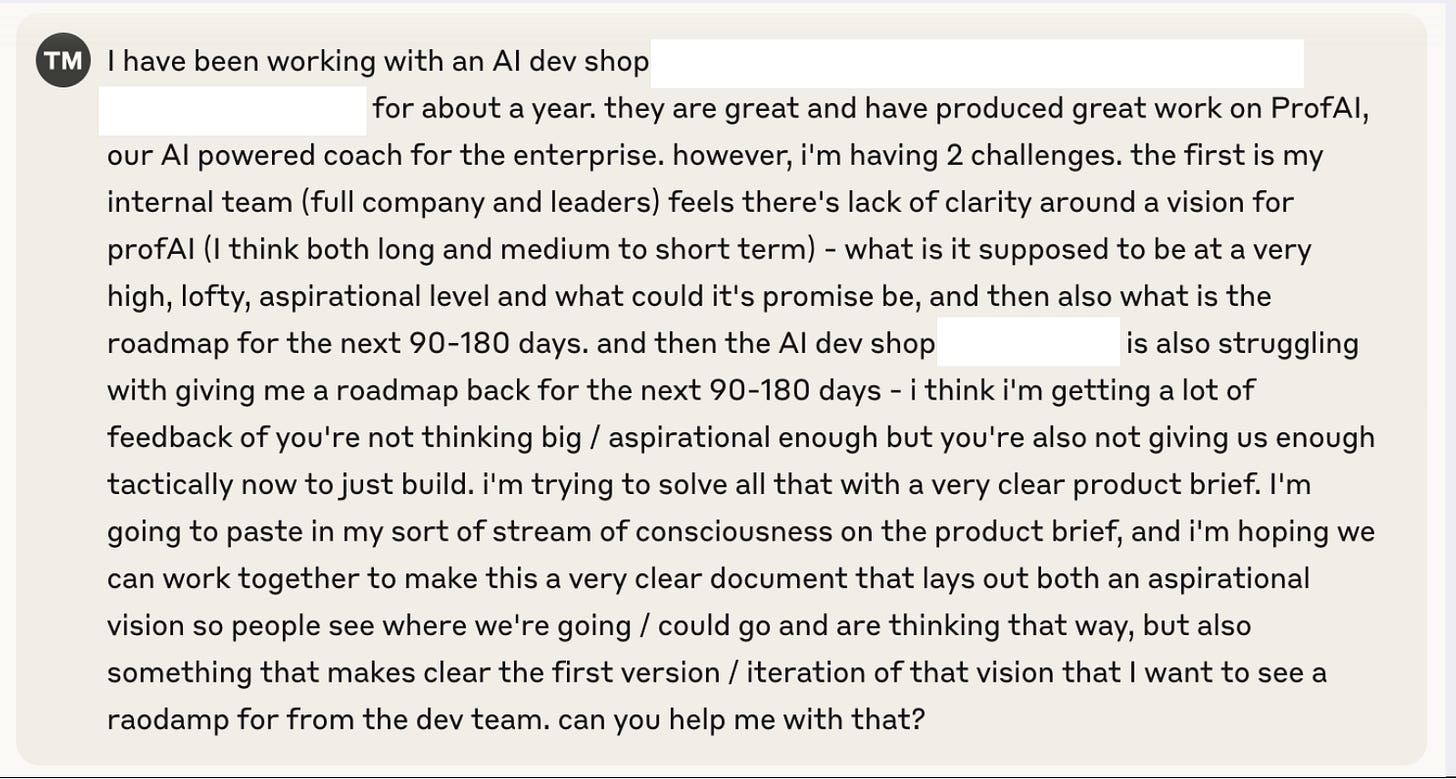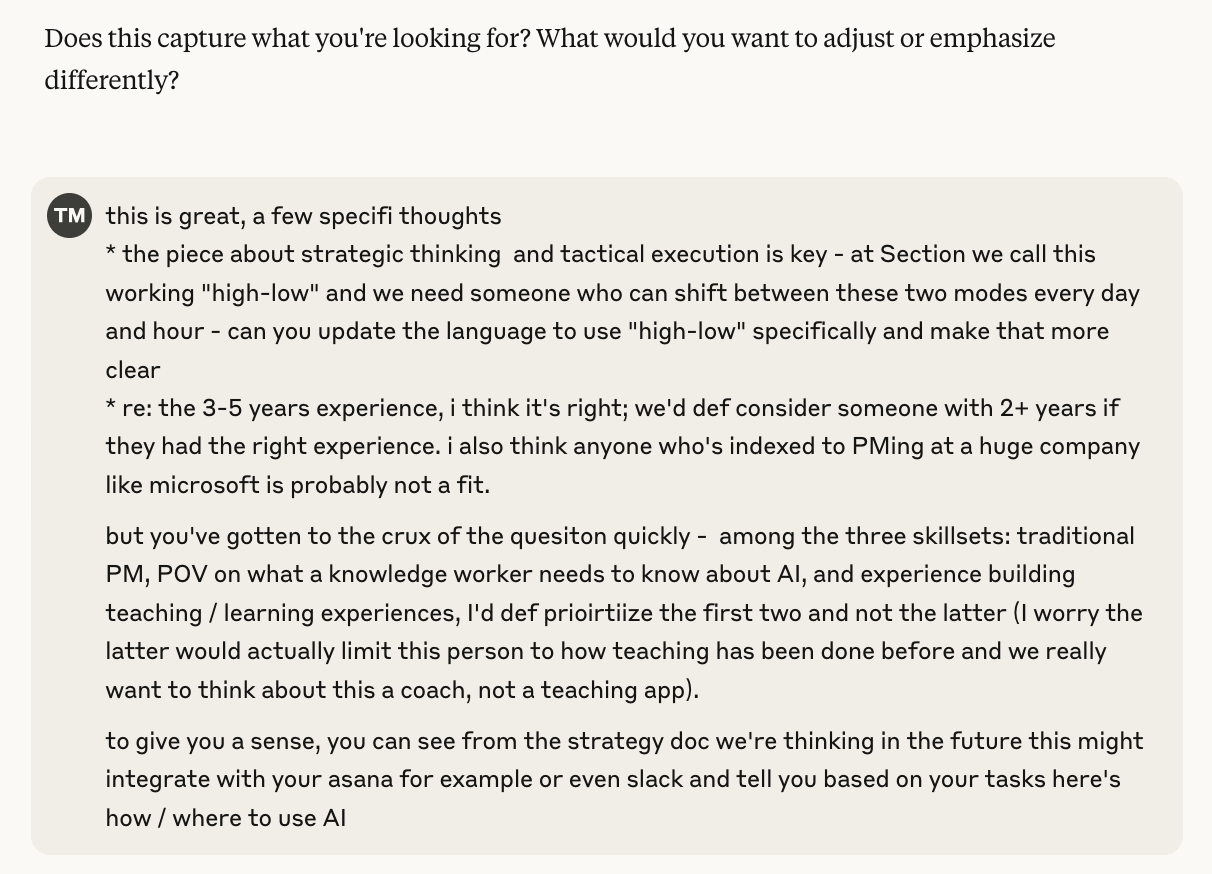You're bad at using AI because you're bad at managing people
It’s the same skill
👋 Hi, it's Greg and Taylor. Welcome to our newsletter on everything you wish your CEO told you about how to get ahead.
I still hear a lot of people complain about AI’s output. They usually say one of two things: “It can’t do what I do” or “The quality isn’t good enough yet.”
Then I ask to see their conversations with AI – and I realize the problem.
They want the answer from AI immediately, and they’re not investing time to iterate on its output.
In other words: They’re doing exactly what a bad manager (or a time-strapped one) does with their direct reports.
I get it – I’m extremely busy too, especially coming back from maternity leave. But I’ve also found that AI performs WAY better for me when I spend more time in each conversation, operating like I would as a people manager.
It takes more time to articulate assignments, give thoughtful feedback, and provide direction, for people AND AI. But you’ll save time in the long run – and go further – if you invest. Here’s how to do it.
– Taylor
Why bad output = bad management
I’m sure you’ve experienced this: You give a direct report an assignment, and they come back with something way off the mark from what you expected.
When this happens to me, it’s usually for one of three reasons:
I haven’t articulated what I’m looking for clearly enough (sometimes to myself, definitely to them)
I haven’t given them clear enough feedback on their V1 (especially when I just jump in and fix it myself)
I haven’t spent enough quality time with them – showing them how I think, engaging with their work, etc.
Great managers do all three things really well with their direct reports. But it requires lots of 1:1 time, revisions, and letting your teammate go back and try again.
AI is the same, with one added bonus – going back and “trying again” takes AI 10-15 seconds vs. the hours/days you’d wait on your teammate.
The 3 missing steps to manage your AI (and your humans)
If you treat AI like an answer generator, it’ll give you a below-average output. Here’s how to coach it to perform like a top-performing human.
1. Articulate the problem, not just the output
Too many people jump straight to the output: “Build me a product strategy brief for ProfAI, our AI-powered coach.” If I do this, AI’s output usually feels way off base, even if I give it context about what ProfAI is.
What works better is giving AI the problem I’m trying to solve.
Here’s how I started a recent conversation with AI. Note: It’s long – and not polished. Because I’m looking for thought partnership, I’m not starting with a highly structured prompt. Instead, I’m specific and honest about the problem I’m trying to solve, giving AI the same background I’d give a colleague.
The key to doing this well: First, YOU need to be clear about the problem you’re trying to solve. That’s true with humans and AI.
You can even use AI to help you do that – start by saying, “I’m trying to articulate the problem I’m trying to solve with [initiative]. Can you guide me through the best way to frame it?”
2. Give specific feedback
Now that AI can create a first draft, my instinct is to copy and paste the output and start editing myself.
But this is a mistake – just like when I jump into a doc from a teammate and start making edits for them. It limits what AI can do, now and in the future.
Instead of editing directly, give feedback and then work together on the next version.
Here’s what I told AI after it drafted a job description for a new product manager.
Here, I’m giving two types of feedback:
Specific, tactical feedback about portions of the document (i.e. call out “high-low”, confirming the assumed years of experience)
Background information to better contextualize my feedback (in this case, I uploaded an additional strategy document to help AI understand some nuances I’m looking for in a product manager)
Just like with humans, specific feedback leads to better, on-the-mark output.
And what’s amazing about AI is the minute you give the feedback, it gives you a new version to react to (vs. spending hours/days to get you V2).
3. Spend quality time
We’ve been sold on AI’s impact on productivity – i.e., “AI will save you time.”
I firmly believe AI is saving me time and improving my work. But I’m spending MORE time with AI to get this benefit, not less.
I spent 45 minutes with AI to create the ProfAI strategy document I talked about above. That document has summarized ProfAI’s vision and connected it to our roadmap better than any other document I’ve made.
Without AI, I’d have spent a few days getting to this place, or never gotten there.
I still spent two hours total – 45 min with AI, 30 min editing myself, 30 min having my Head of Marketing review a first version as a gut check, and another 15 min finalizing – before I shared with the team.
It’s not a silver bullet. Just like with humans, you get what you put in. You won’t get amazing work with a single prompt.
Our advice
We’re all guilty of using AI like a search engine. And that makes sense – we’re used to Google Search, and half the AI models are billing themselves as a way to get answers fast.
But AI’s superpower isn’t search – it’s conversation. So treat it like a human that you see potential in, and make a real investment in the conversation if you want a better output.
Still skeptical? Don’t think you have enough time? Here’s our blunt opinion: It’s irresponsible for executives not to consult AI for any medium- to high-stakes decision. So take one high-stakes decision you have coming up, and have a real conversation with AI. Then judge the value it adds.
You wouldn’t give up on a high-potential direct report that quickly. So don’t give up on AI without some real effort.
Have a great week,
Greg & Taylor




My fav sentence in this piece is this:
AI’s superpower isn’t search – it’s conversation
Using voice mode has allowed me to do this with abandon and for me has been quite the shift. My fav thing to do is to get AI to pretend to be diff people so I get various perspectives I might have missed
Spot on, Greg & Taylor! "AI’s superpower isn’t search – it’s conversation." AI, like humans, are not mindreaders if one gives vague/unclear input. Both need sufficient context and clarity to meet your expectations. I think one added bonus with AI is that as you have to write you what you want to say to AI, you are forced to be more concise. Bad managers, who give unclear oral tasks probably would be often unable to understand their own orally given sentences :D